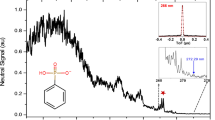Abstract
The mechanistic aspects of the photochemistry of several iminosulfonate photoacid generators (PAGs) have been studied based on product analysis, nanosecond laser flash photolysis, and determination of acid generation efficiencies. Our findings support a competition between homolytic and heterolytic N–O dissociation mechanisms. By measuring the efficiencies of acid generation for each PAG in the presence and absence of an ion quencher, we were able to roughly quantify the degree of branching between heterolytic and homolytic photocleavage pathways for each PAG. The p-toluenesulfonyloxyl radical was detected upon laser flash photolysis of several PAGs and was found to have a λmax at 540 nm. By quenching the 540 nm transient with a variety of reactive species, the rate constants for reaction of the p-toluenesulfonyloxyl radical with these substrates were determined. The p-toluenesulfonyloxyl radical is shown to be a highly reactive species, which undergoes rapid hydrogen transfer and is a powerful oxidizer.
Similar content being viewed by others
References
For example: (a) M. Shirai, T. Masuda, H. Ishida, M. Tsunooka and M. Tanaka, Imino Sulfonates as Novel Photocrosslinking Agents for Poly(2,3-Epoxypropyl Methacrylate) in Film, Eur. Polym. J., 1985, 21, 781–786
M. Shirai, M. Tsunooka, M. Tanaka, K. Nishijima and K. Ishikawa, Synthesis and Photo-Induced Dissolution of Polymers Bearing Imino Sulfonate Groups, J. Polym. Sci. A: Polym. Chem., 1989, 27, 325–332
M. Shirai, H. Kinoshita and M. Tsunooka, Deblocking of Poly(4-t-Butoxycarbonyloxystyrene) using Imino Sulfonates as Photoacid Generators, Eur. Polym. J., 1992, 28, 379–385
M. Shirai, H. Kinoshita and M. Tsunooka, Photo-Thermal Properties of Poly(4-tert-Butoxycarbonyloxystyrene) Bearing Imino Sulfonate Units, J. Polymer Sci. A: Polym. Chem., 1993, 31, 451–455
M. Shirai, T. Sumino and M. Tsunooka, Polysiloxane Formation at the Irradiated Surface of Polymers Containing Both Photoacid Generating Units and Epoxy Units, Eur. Polym. J., 1997, 33, 1255–1262
M. Shirai, N. Nogi and M. Tsunooka, Photo-Assisted Thermal Crosslinking of Polymers Having Imino Sulfonate Units, React. Func. Polym., 1998, 37, 147–154.
H. J. Hageman, P. Oosterhoff and J. Verbeek, Photoinitiators and photoinitiation Part 15. The photodecomposition of some [Z]-O-sulfonyl 2-oximinoketones and some [Z]-O-sulfamoyl 2-oximinoketones, J. Photochem. Photobiol. A: Chem., 1999, 121, 207–211
J. Lalevée, X. Allonas, J.-P. Fouassier, M. Shirai and M. Tsunooka, Photocleavage Processes in an Iminosulfonate Derivative Usable as Photoacid in Resist Technology, Chem. Lett., 2003, 32, 178–179.
J. C. Scaiano, M. Tanner and D. Weir, Exploratory Study of the Intermolecular Reactivity of Excited Diphenylmethyl Radicals, J. Am. Chem. Soc., 1985, 107, 4396–4403
J. C. Scaiano, Solvent Effects in the Photochemistry of Xanthone, J. Am. Chem. Soc., 1980, 102, 7747–7753.
G. Pohlers, J. C. Scaiano and R. Sinta, A Novel Photometric Method for the Determination of Photoacid Generation Efficiencies Using Benzothiazole and Xanthene Dyes as Acid Sensors, Chem. Mater., 1997, 9, 3222–3230.
G. Pohlers, J. C. Scaiano, R. Sinta, R. Brainard and D. Pai, Mechanistic Studies of Photoacid Generation from Substituted 4,6-Bis(trichloromethyl)-1,3,5-triazines, Chem. Mater., 1997, 9, 1353–1361.
F. Ortica, C. Coenjarts, J. C. Scaiano, H. Liu, G. Pohlers and J. F. Cameron, Mechanism of Reaction and Photoacid Generation of N-Oxysuccinimidoarylsulfonate PAGs: A Laser Flash Photolytic Study, Chem. Mater., 2001, 13, 2297–2304.
F. Ortica, C. Coenjarts, J. C. Scaiano, H. Liu, G. Pohlers and J. F. Cameron, Mechanism of Reaction and Photoacid Generation of N-Oxysuccinimidoarylsulfonate PAGs: A Laser Flash Photolytic Study, Chem. Mater., 2001, 13, 2297–2304.
H.-G. Korth, A. G. Neville and J. Lusztyk, Direct Spectroscopic Detection of Sulfonyloxyl Radicals and First Measurements of Their Absolute Reactivities, J. Phys. Chem., 1990, 94, 8835–8839.
J. T. Banks, K. U. Ingold and J. Lusztyk, Measurement of Equilibrium Constants for Complex Formation between Phenol and Hydrogen-Bond Acceptors by Kinetic Laser Flash Photolysis, J. Am. Chem. Soc., 1996, 118, 6790–6791
D. W. Snelgrove, J. Lusztyk, J. T. Banks, P. Mulder and K. U. Ingold, Kinetic Solvent Effects on Hydrogen-Atom Abstractions: Reliable, Quantitative Predictions via a Single Empirical Equation, J. Am. Chem. Soc., 2001, 123, 469–477.
P. Vanýsek, Electrochemical Series, in Handbook of Chemistry and Physics, ed. D. R. Lide, CRC Press, Inc., Boca Raton, FL, 73rd edn., 1992, p. 8–17–8–27.
Author information
Authors and Affiliations
Rights and permissions
About this article
Cite this article
Arnold, P.A., Fratesi, L.E., Bejan, E. et al. Evidence of homolytic and heterolytic pathways in the photodissociation of iminosulfonates and direct detection of the p-toluenesulfonyloxyl radical. Photochem Photobiol Sci 3, 864–869 (2004). https://doi.org/10.1039/b407801b
Received:
Accepted:
Published:
Issue Date:
DOI: https://doi.org/10.1039/b407801b




